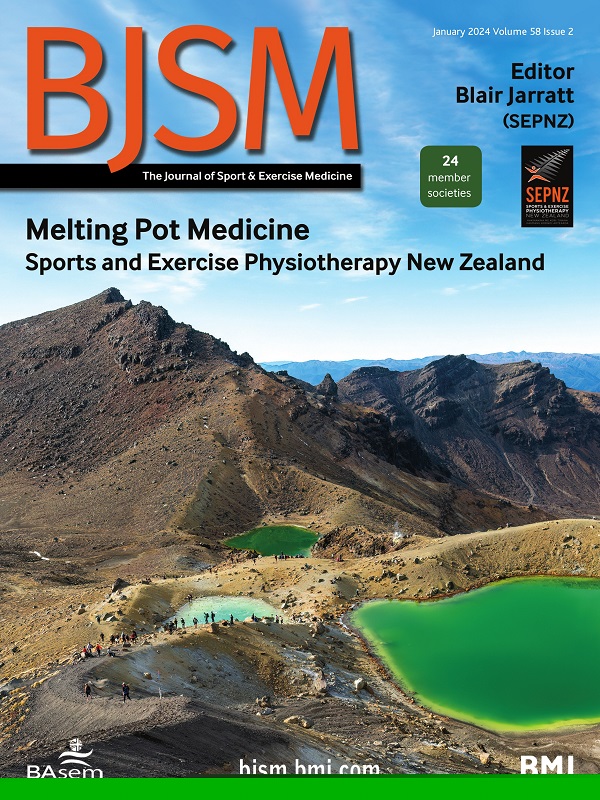Role of exercise in atrial fibrillation management
IF 16.2
1区 医学
Q1 SPORT SCIENCES
引用次数: 0
Abstract
Atrial fibrillation (AF) is the most common sustained cardiac arrhythmia encountered in clinical practice and presents a significant and growing public health challenge. In a rigorously conducted Cochrane systematic review, meta-analysis and meta-regression, Buckley et al 1 examine the efficacy and safety of exercise-based cardiac rehabilitation (ExCR) in individuals with AF.1 This editorial seeks to interpret their findings in the context of contemporary sport and exercise medicine, exploring how structured exercise plays a role in the management of patients with AF. If we were to assess the global socioeconomic landscape through the lens of health, the rising incidence and prevalence of AF and the strategies to mitigate this widespread trend would occupy a central place in the minds of healthcare providers and clinicians. AF is the most frequently diagnosed arrhythmia, with a global prevalence exceeding 59 million.2 Its prevalence increases significantly with age, particularly beyond 65 years. The arrhythmia is strongly associated with stroke and heart failure, making it a substantial contributor to both morbidity and mortality. Global trends demonstrate a doubling in the incidence of AF over the past 30 years, with higher rates among males compared with females. Global deaths attributed to AF have almost tripled in recent decades, primarily attributable to the increased incidence of cases among males (42 511 in 1990 to 121 548 in 2019).3 Individuals of both sexes aged between 65 and 69 years demonstrate the highest incidence rates, which peak in the 75–79 year age group.3 Disability-adjusted life years (DALYs) are generally lower for females than males across all age groups. DALYs are predominantly linked to high levels of systolic blood pressure (39%) and high body mass index (BMI, >20%), both of which are risks that can be mitigated through regular exercise. Rising risk factors such as obesity, diabetes, hypertension, physical …运动在房颤治疗中的作用
心房颤动(AF)是临床实践中最常见的持续性心律失常,并提出了一个重要的和日益增长的公共卫生挑战。在一项严格执行的Cochrane系统综述、荟萃分析和荟萃回归中,Buckley等人1检查了AF患者运动基础心脏康复(ExCR)的有效性和安全性。这篇社论试图在当代体育和运动医学的背景下解释他们的发现,探索有组织的运动如何在AF患者的管理中发挥作用。如果我们要通过健康的视角评估全球社会经济景观,房颤发病率和流行率的上升以及缓解这一普遍趋势的策略将在医疗保健提供者和临床医生的脑海中占据中心位置。房颤是最常见的心律失常,全球患病率超过5900万其患病率随着年龄的增长而显著增加,尤其是65岁以上。心律失常与中风和心力衰竭密切相关,使其成为发病率和死亡率的重要因素。全球趋势表明,过去30年房颤发病率翻了一番,男性发病率高于女性。近几十年来,全球因房颤死亡的人数几乎增加了两倍,主要原因是男性发病率增加(1990年为42 511人,2019年为121 548人)65岁至69岁的男女发病率最高,75岁至79岁年龄组发病率最高在所有年龄组中,女性的残疾调整生命年(DALYs)普遍低于男性。DALYs主要与高收缩压(39%)和高体重指数(BMI, >20%)有关,这两种风险都可以通过定期锻炼来减轻。不断上升的危险因素,如肥胖、糖尿病、高血压、身体……
本文章由计算机程序翻译,如有差异,请以英文原文为准。
求助全文
约1分钟内获得全文
求助全文
来源期刊
CiteScore
27.10
自引率
4.90%
发文量
217
审稿时长
3-8 weeks
期刊介绍:
The British Journal of Sports Medicine (BJSM) is a dynamic platform that presents groundbreaking research, thought-provoking reviews, and meaningful discussions on sport and exercise medicine. Our focus encompasses various clinically-relevant aspects such as physiotherapy, physical therapy, and rehabilitation. With an aim to foster innovation, education, and knowledge translation, we strive to bridge the gap between research and practical implementation in the field. Our multi-media approach, including web, print, video, and audio resources, along with our active presence on social media, connects a global community of healthcare professionals dedicated to treating active individuals.

 求助内容:
求助内容: 应助结果提醒方式:
应助结果提醒方式:


